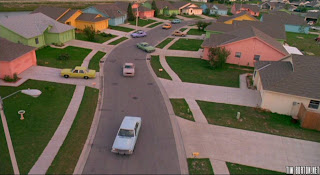Having previously discussed in this blog, Tim Burton has a passion for recreating the suburbia that he grew up in, this suburban life; A life rich with 1950's American suburban dream, he describes it as a kind of colourless, flat landscape in which no one really knew anyone else beneath the façade of normalcy. He describes his experience of living in suburbia as having 'no passion for anything, just a quiet, kind of floaty kind of semi-oppressive blank palette that you're living in'. His work recreates elements of subversion that stiffly infiltrates a conservative world. Some people may argue that this kind of society does not exist but i will argue that we are living in it. It’s called social control and we are governed by each other, adapting to patterns and routine, slotting into the norm of the everyday. Following the traffic, following the signs, get up in daylight, go to sleep in nightlight, eat healthy, buy fair-trade, and love thy neighbour...
The situationist- Henri Lefebvre wrote in 1965 in relation to the Parisian uprising;'' Propose not a concrete utopia, but an abstraction.do they really believe that one fine day, or one decisive evening, that people will look at each other and say, to hell with work, to hell with boredom! lets put an end to it!- and that everyone will then step into the eternal festival and the creation of situations.''
He said that everyday life was a 'backward sector'.
In the 1980's a group of postmodernist artists began to emerge. these artists focused their attention towards postmodern culture, influenced by Debordian views.
Roger Brown. Talk Show Addicts, 1993. Etching
In Talk Show Addicts by Artist Roger Brown, We are presented with a late night view of a suburban neighborhood. To me, it represents suburbia at its finest, illustrating this community as a Utopian society, every house being consumed by the television media, watching the same channel etc.
This image we see could be an image by that of Debord, his view of the world described in Society of the Spectacle (1967). Identical houses contain almost identical, late-night TV viewers watching almost identical programs. Despite living in such close proximity, television watching has become the collective tie which binds them. Even though Brown has created this community in such close proximity to one another the artist is drawing awareness and attention that these disconnected suburbanites have become isolated within themselves and within society.
Brown, a member of an artist group called 'imaginists', creates whimsical and edgy works of urban cityscape's touching on social issues.




No comments:
Post a Comment